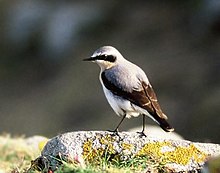Wheatear
| Wheatears | |
|---|---|

| |
| Malenorthern wheatear(Oenanthe oenanthe) | |
| Scientific classification | |
| Domain: | Eukaryota |
| Kingdom: | Animalia |
| Phylum: | Chordata |
| Class: | Aves |
| Order: | Passeriformes |
| Family: | Muscicapidae |
| Subfamily: | Saxicolinae |
| Genus: | Oenanthe Vieillot,1816 |
| Type species | |
| Motacilla oenanthe[1] Linnaeus, 1758
| |
| Species | |
|
See text | |
| Synonyms | |
|
Cercomela | |
Thewheatears/ˈhwiːtɪər/arepasserinebirdsof thegenusOenanthe.They were formerly considered to be members of thethrushfamily, Turdidae, but are now more commonly placed in theflycatcherfamily,Muscicapidae.This is anOld Worldgroup, but thenorthern wheatearhas established a foothold in easternCanadaandGreenlandand in western Canada andAlaska.
Taxonomy
[edit]The genusOenanthewas introduced by the French ornithologistLouis Pierre Vieillotin 1816 withOenanthe leucura,theblack wheatear,as thetype species.[2][3]The genus formerly included fewer species butmolecular phylogeneticstudies of birds in the Old World flycatcher familyMuscicapidaefound that the genusCercomelawaspolyphyleticwith five species, including the type speciesC. melanura,phylogenetically nested within the genusOenanthe.[4][5]This implied thatCercomelaandOenantheweresynonyms.The genusOenanthe(Vieillot,1816) has taxonomic priority overCercomela(Bonaparte,1856) makingCercomelaa junior synonym.[4][6]The genus nameOenanthewas used by Aristotle for an unidentified bird. The word is derived from the Greekoenoēmeaning "vine" andanthosmeaning "bloom". The bird was associated with the grape harvest season.[7]
Thename"wheatear" is not derived from "wheat"or any sense of"ear",but is afolk etymologyof "white" and "arse",referring to the prominent white rump found in most species.[8]
Description
[edit]Most species have characteristic black and white or red and white markings on their rumps or their long tails. Most species are stronglysexually dimorphic;only the male has the striking plumage patterns characteristic of the genus, though the females share the white or red rump patches.
Species list
[edit]The genus contains 33 species:[9]
- Northern wheatear,Oenanthe oenanthe
- Atlas wheatear,Oenanthe seebohmi[10]
- Capped wheatear,Oenanthe pileata
- Buff-breasted wheatear,Oenanthe bottae– formerly the red-breasted wheatear
- Rusty-breasted wheatear,Oenanthe frenata– split fromO. bottae
- Heuglin's wheatear,Oenanthe heuglinii
- Isabelline wheatear,Oenanthe isabellina
- Hooded wheatear,Oenanthe monacha
- Desert wheatear,Oenanthe deserti
- Western black-eared wheatear,Oenanthe hispanica
- Eastern black-eared wheatear,Oenanthe melanoleuca
- Cyprus wheatear,Oenanthe cypriaca
- Pied wheatear,Oenanthe pleschanka
- White-fronted black chat,Oenanthe albifrons(formerly in eitherPentholaeaorMyrmecocichla)
- Somali wheatear,Oenanthe phillipsi
- Red-rumped wheatear,Oenanthe moesta
- Blackstart,Oenanthe melanura(formerly inCercomela)
- Familiar chat,Oenanthe familiaris(formerly inCercomela)
- Brown-tailed rock chat,Oenanthe scotocerca(formerly inCercomela)
- Sombre rock chat,Oenanthe dubia(formerly inCercomela)
- Brown rock chat,Oenanthe fusca(formerly inCercomela)
- Variable wheatear,Oenanthe picata
- Black wheatear,Oenanthe leucura(type species)
- Abyssinian wheatear,Oenanthe lugubris
- White-crowned wheatear,Oenanthe leucopyga
- Hume's wheatear,Oenanthe albonigra
- Finsch's wheatear,Oenanthe finschii
- Maghreb wheatear,Oenanthe halophila[10]
- Mourning wheatear,Oenanthe lugens
- Basalt wheatear,Oenanthe warriae[10]
- Arabian wheatear,Oenanthe lugentoides
- Kurdish wheatear,Oenanthe xanthoprymna
- Red-tailed wheatear,Oenanthe chrysopygia
Behaviour
[edit]Wheatears are terrestrial insectivorousbirdsof open, often dry, country. They often nest in rock crevices or disused burrows. Northern species are long-distancemigrants,wintering inAfrica.
Fossil record
[edit]- Oenanthe kormosi(Late Miocene of Polgardi, Hungary)[11]
- Oenanthe pongraczi(Pliocene of Csarnota, Hungary)[11]
References
[edit]- ^"Muscicapidae".aviansystematics.org.The Trust for Avian Systematics.Retrieved15 July2023.
- ^Mayr, Ernst;Paynter, Raymond A. Jr, eds. (1960).Check-list of Birds of the World.Vol. 10. Cambridge, Massachusetts: Museum of Comparative Zoology. p. 121.
- ^Vieillot, Louis Pierre(1883) [1816]. Saunders, Howard (ed.).Vieillot's Analyse d'une nouvelle ornithologie élémentaire(in French). London. p. 43.
{{cite book}}:CS1 maint: location missing publisher (link) - ^abOutlaw, R.K.; Voelker, G.; Bowie, R.C.K. (2010). "Shall we chat? Evolutionary relationships in the genusCercomela(Muscicapidae) and its relation toOenanthereveals extensive polyphyly among chats distributed in Africa, India and the Palearctic ".Molecular Phylogenetics and Evolution.55(1): 284–292.Bibcode:2010MolPE..55..284O.doi:10.1016/j.ympev.2009.09.023.PMID19772925.
- ^Aliabadian, M.; Kaboli, M.; Förschler, M.I.; Nijman, V.; Chamani, A.; Tillier, A.; Prodon, R.; Pasquet, E.; Ericson, P.G.P.; Zuccon, D. (2012). "Convergent evolution of morphological and ecological traits in the open-habitat chat complex (Aves, Muscicapidae: Saxicolinae)".Molecular Phylogenetics and Evolution.65(1): 35–45.Bibcode:2012MolPE..65...35A.doi:10.1016/j.ympev.2012.05.011.PMID22634240.
- ^Sangster, George; Collinson, J. Martin; Crochet, Pierre-André; Knox, Alan G.; Parkin, David T.; Votier, Stephen C. (2013)."Taxonomic recommendations for Western Palearctic birds: ninth report".Ibis.155(4): 898–907 [903].doi:10.1111/ibi.12091.
- ^Jobling, James A. (2010).The Helm Dictionary of Scientific Bird Names.London: Christopher Helm. p. 280.ISBN978-1-4081-2501-4.
- ^"Wheatear".Merriam Webster Online.Retrieved13 May2010.
- ^Gill, Frank;Donsker, David;Rasmussen, Pamela,eds. (January 2023)."Chats, Old World flycatchers".IOC World Bird List Version 13.1.International Ornithologists' Union.Retrieved7 February2023.
- ^abc"Species Updates – IOC World Bird List".Retrieved27 May2021.
- ^abKessler, E. 2013. Neogene songbirds (Aves, Passeriformes) from Hungary. – Hantkeniana, Budapest, 2013, 8: 37–149.
